
If you wanted to recruit for data science talent at a university, where would go? Should you go to the College of Computing? Would it be in the College of Business? Is it in the Department of Mathematics? Statistics? Is there even a Department of Data Science?
There is more variation in the housing of data science than any other academic discipline on a university campus. Why the variation? And why should you care?
The answer to the first question Why the variation? may not be straightforward.
As in any organization, not all academic programs are a function of long-term, well-considered strategic planning many analytics programs evolved at the intersection of resources, needs, and opportunity (and some noisy passionate faculty). As universities began to formally introduce data science programs around 2006, there was little consistency regarding where this new discipline should be housed. Given the academic ancestry of analytics and data science it is not surprising that there is variation of placement of programs across the academic landscape:
Exacerbating this, we do not yet have a universal consensus as to what set of competencies should be common to a data science curriculum again largely due to its transdisciplinary foundations. The fields of computer science, mathematics, statistics, and almost every applied field (business, health care, engineering) have professional organizations and long-standing models for what constitutes competency in those fields. Data science has no standardization, no accreditation, and no certifying body. As a result, the data science curriculum may look very different at different universities – all issues that have contributed to the misalignment of expectations for both students and for hiring managers.
The second question (why should you care?) might be more relevant
Generally, universities have approached the evolution of data science from one of two perspectives as a discipline spoke (or series of electives) or as a discipline hub (as a major) as in the graphic above.
University programs that are hubs reflecting the model above on the left have likely been established as a major field of study. These programs are likely to be housed in a more computational college (e.g., Computing, Science, Statistics) or in a research unit (like a Center or Institute) and will focus on the science of the data. They tend to be less focused on the nuances of any individual area of application. Hub programs will (generally) allow (encourage) their students to take a series of electives in some application domain (i.e., students coming out of a hub program may go into Fintech, but they may also go into Healthcare their major is data). Alternatively, programs that are spokes reflecting the model above on the right are more likely to be called analytics and are more frequently housed in colleges of business, medicine, and the humanities. Programs that are spokes are (generally) less focused on the computational requirements and are more aligned with applied domain-specific analytics. Students coming out of these programs will have stronger domain expertise and will better understand how to integrate results into the original business problem but may lack deep computational skills. Neither is wrong or better the philosophical approaches are different.
Understanding more about where an analytics program is housed and whether analytics is treated as a “hub” or a “spoke” should inform and improve analytics professionals collaborative experiences with universities.
To learn more – the book “Closing the Analytics Talent Gap: An Executive’s Guide to Working With Universities ” is available through Amazon and directly from the publisher CRC Press.

